#Ecology and Evolution
Link
RESEARCH ARTICLE:
Museum specimens of a landlocked pinniped reveal recent loss of genetic diversity and unexpected population connections
University of Oulu
#Yle.fi#Ecology and Evolution#Suomi#Finland#Oulun Yliopisto#University of Oulu#research#Itäsuomi#Itä-Suomi#East Finland#Saimaa#Lake Saimaa#Saimaan norppa#Saimaa Ringed Seal#Pusa hispida saimensis#Phoca hispida saimensis#Genetiikka#Genetics#DNA#mtDNA#dna sequencing#suomitumblr#suomitumppu#suomi tumppu#suomi tumblr#suomijutut
5 notes
·
View notes
Text
The Lancetfish is a species that looks like it comes straight out of a realistic fantasy world building project.
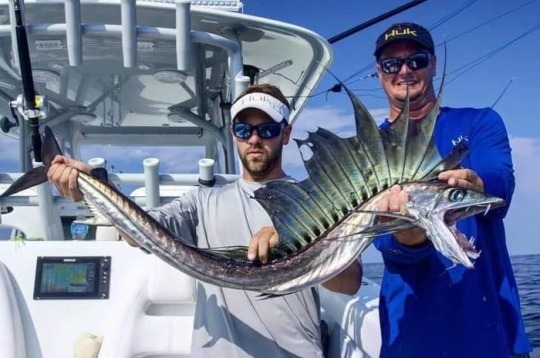
#speculative biology#speculative ecology#speculative evolution#speculative zoology#traditional art#traditional sketch#spectember#specposium#paleontology#fanart#paleo meme#paleo art#paleontologist#paleostream#paleobird#paleomedia#paleoblr#paleoillustration#paleoart#worldbuilding#world#fishing#world building#fantasy#realistic fantasy#fish#lancet fish#lancetfish
68K notes
·
View notes
Text
Okay, so this is really cool! You have this phenomenon where some plants grow edible appendages to their seeds to entice ants to carry them underground where they can safely sprout. And then you have wasps which lay their eggs on the leaves, stems, and other parts of plants and trigger the growth of galls (swellings) which both feed and protect the wasp larvae until they reach maturity.
The boy who was watching the ants noticed they were taking wasp galls underground, too. Further exploration found that the wasp larvae were unharmed inside the galls; the only thing the ants had eaten were edible appendages similar to those on the seeds they collected. The wasp larvae stayed safe inside the ant nest, feeding on their galls, until it was time to emerge and head back out to the surface.
So it turns out that the edible portions of the galls have the same sorts of fatty acids as the edible parts of the seeds. And those fatty acids are also found in dead insects. Scientists think that the wasps evolved a way to make the galls they created mimic the edible portions of the seeds to get the ants to collect the galls. This isn't the only example of wasps making use of ants as caretakers for their young, but it's a really fascinating example thereof--especially if you consider ants evolved from wasps at least 100 million years ago.
#wasps#ants#plants#galls#oak galls#insects#invertebrates#Hymenoptera#ecology#bugs#animals#wildlife#nature#trees#entomology#science#natural science#evolution#animal behavior
13K notes
·
View notes
Text
When hunting for mice in winter, red and Arctic fox are known to plunge headfirst at speeds of 2–4 meters per second, but their sharp noses reduce the impact force in snow and protect them from injury, according to a new Cornell University study.
The fundamental research sheds light on the biomechanics of the unique hunting behavior (known as mousing), advances our understanding of animal adaptations and offers insights into snow injuries people experience during snowboarding or skiing.
The study appears in the Proceedings of the National Academy of Sciences.
Continue Reading.
833 notes
·
View notes
Text
Lobe finned versus ray finned fish

Short answer: ray finned fish evolved from from lobe finned fish
Long answer: Lobe finned fish were dominant for a long time in the waters before they climbed up onto land and evolved into you, dear reader. This occurred around 400 MYA (million years ago). Sometime before that, about 425 MYA, ray finned fishes had evolved, but remained relatively small. This was until the permian mass extinction (290-245 MYA), when many lobe finned fish died out, and ray finned fishes (teleosts) were left to flourish and evolve to fill the empty evolutionary niches. The only lobe finned fish left behind today are the elusive coelacanths and lungfish. ***AND*** as the awesome people in the notes would like me to add, all tetrapods (tetra meaning four, pod meaning foot) are phylogenetically lobe finned fishes as well. this means amphibians, reptiles, and mammals.
@marinebiologyshitposts @fuckyeahcoelacanths
#marine biology#lobe finned fish#ray finned fish#coelacanth#evolution#science#things ya should know#zoology#biology#ecology#animal facts#animals
1K notes
·
View notes
Text

Zaabua redesign as I was unhappy how puppet like their older design was, even though that was part of their charm and I loved them for that. I wanted them to resemble more of an alien life form that fit within their ecosystems and that was something I don’t think I was capturing well on the older designs. I gave them more robust eye stalks that are now face each other, this would shield their eyes from harsh snow fall and added girth allows for more heat retention to the eyes. They still have the ability to retract their eye stalks into their heads.
I kept their large chubby body and give them thinner longer legs that now no longer have knee joints but rely on a completely different inner movement system that does not rely on bones or certain. But focuses more on their muscles and water works. I’m thinking of a hydrologic like system that insects have.
#spec bio#speculative biology#alien species#speculative evolution#artists on tumblr#spec evo#speculative fiction#xenobiology#speculative ecology#speculative worldbuilding#Zaabua redesign#land of borease
448 notes
·
View notes
Text
Wet Beast Wednesday: cave fish
Prepare for a deep dive today. Not because I'm going to be more in-depth than usual, but because we're talking about caves. Which are deep. In the ground.... Yeah, you get it. Today is going to be a bit different from my normal WBW posts. Instead of going in depth on a particular species or group of related species I'm going to discuss common adaptations fish evolve to live permanently in caves and then go over a few species I find interesting. Let's get spelunking.
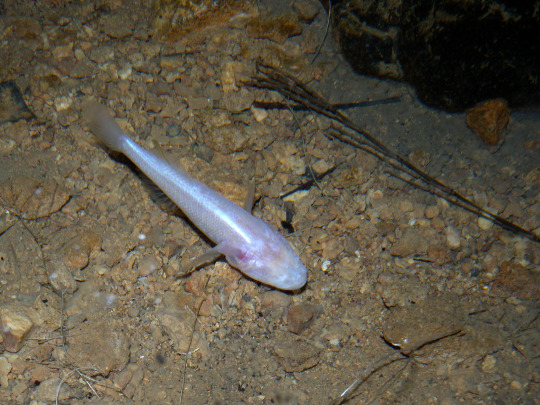
(Image: Typhleotris madagascariensis, a typical cave fish. It is a small fish with an entirely white body and smooth skin where the eyes would be on a normal fish. It is resting on rocky sediment. End ID)
Caves are not an easy place to live. There's no light, limited food, often low oxygen levels, and the threat of collapse or rockfall. Cave-swelling animals (collectively called troglofauna) need a number of special adaptations to survive and there is little room for error. Troglofauna that are strictly aquatic are called stygofauna. Troglofauna and stygofauna can be divided into three groups based on their life history. Troglophiles and stygophiles complete part of their life cycle in caves and part outside of them. A classic example of this is the many species of bat who seasonally inhabit caves to give birth and mate. Trogloxenes and stygoxenes are animals who will visit caves, but do not require time in caves to complete their life cycle. An example trogloxene would be a bear who takes shelter in a cave during winter. Finally, troglobites and stygobites live their entire lives in caves and never leave. The fish I discuss today are stygobites. Because troglobites and stygobites generally will die outside of their caves, they have very little opportunity to disperse. As such, many cave fish species are found only in a single cave or cave system and are entirely dependent on the health of their homes to survive.
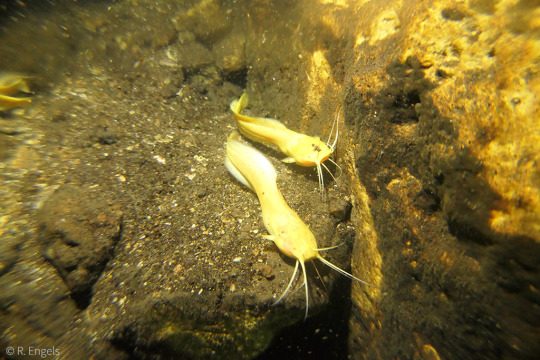
(Image: two cave catfish sitting next to each other on a rock. They are white with elongated anal and rear dorsal fins, and no eyes. End ID)
Many cave-dwelling animals develop a set of common adaptations called troglomorphism. Cave water is often high in minerals but low in oxygen and food content. To survive, the fauna develop very slow metabolisms, allowing them to last a long time on limited resources while slowing down movement and other active systems and increasing age. These species are also typically smaller than their epigean (above-ground) relatives, further reducing their energy requirements. Slowed metabolism results in comparatively slow development. Cave species take much longer to mature and reproduce then related epigean species. Many species further decrease their energy consumption by moving as little as possible. Many species of cave fish are able to last long periods of time between meals without negative impacts to their health. They will binge eat whatever they can find and then subsist on fat stores while food is scarce. One test in captivity showed that a Phreatobius cisternarum (cave catfish) could go a while year between meals and stay healthy. Cave species are usually opportunistic generalists as they can't afford to pass up resources. Much of their food will originate outside of the cave, either directly or indirectly. Water flow into caves brings in algae, bacteria, plankton, and other food sources. Other more indirect methods of introducing include bat feces. While the fish may not eat the feces directly, other species may do so and potentially become prey to the cave fish. The feces also introduces nutrients from outside the cave that encourages the growth of other food sources like bacteria, fungi, and planktonic animals.
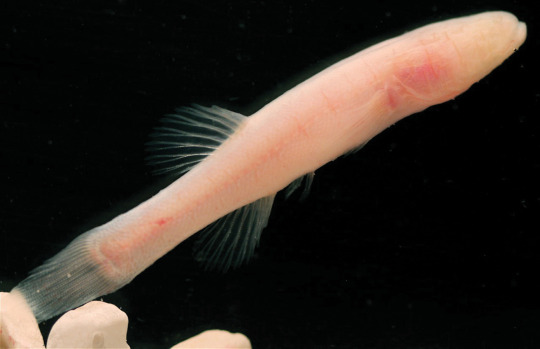
(Image: Amblyopsis hoosieri, the hoosier cave fish. It is a very simplistic fish with no eyes or scales. End ID)
Life in a cave comes with a different sensory requirement. The complete lack of light makes vision useless. You don't know dark until you've seen cave dark. Fun fact: caves are so dark that sighted people can start hallucinating in them because our brains aren't evolved to handle zero visual stimulus and will start making stuff up to fill that gap. As a result of the utter darkness, many species of cave fish are blind. They either evolve to completely lose their eyes or have the eyes considerably reduced in size and function. Eyes take up a lot of energy to maintain and in caves, there is a lot of selective pressure to get rid of organs that aren't useful there. Despite the blindness, many species retain some form of photosensitivity and will flee from light. Cave species also often lack skin pigmentation. Skin pigment has two primary uses. It protects the skin from ultraviolet light in sunlight, and provides skin coloration that can be used for camouflage, displays, warnings, and so on. In an environment where there is no ultraviolet light and everyone is blind, skin pigment serves no real purpose and is lost. As a result, most cave species are white or translucent. The lack of pigment may be a reason so many species remain photosensitive. Without pigment, they would be highly susceptible to sunburn or skin cancer from ultraviolet light. Caves also have a sound dampening effect that makes hearing less valuable. Reduced eyes and pigmentation is also seen in deep sea fish that live too deep for light to reach. Even those species still use visual curs more than cave fish due to the abundance of bioluminescence in the deep ocean.
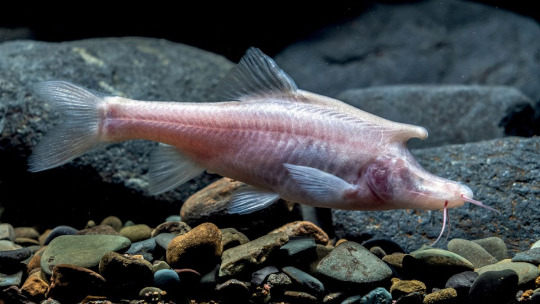
(Image: Sinocyclocheilus longicornus, a recently discovered species. It is a fish with translucent skin, revealing the skeleton. It has a long shout with two pairs of barbels. Emerging from the upper back is a horn-like protrusion. End ID)
With vision off the table, cave fish rely on other senses. chemoreception through taste and smell are strongly selected for as traits that can direct cave animals toward food or away from threats. Another sensory system fish have is the lateral line. The Lateral line is an organ system found on each side of a fish where modified skin cells called hair cells detect motion in the water. The lateral line allows fish to sense movement in the water around them, informing them of water flow and the movement of food and threats. Cave fish typically have a well-developed lateral line system that compensates for the lack of vision. Many fish perform displays for various reasons, such as attracting mates. These displays are typically visual, but in cave fish, that isn't an option. Instead, their displays are more focused on moving the water in ways that can be detected by lateral lines. Some species of cave fish maintain additional sensory abilities from their epigean ancestors. An example of this are cave catfish, who retain the barbels and electroreception common to their kind.
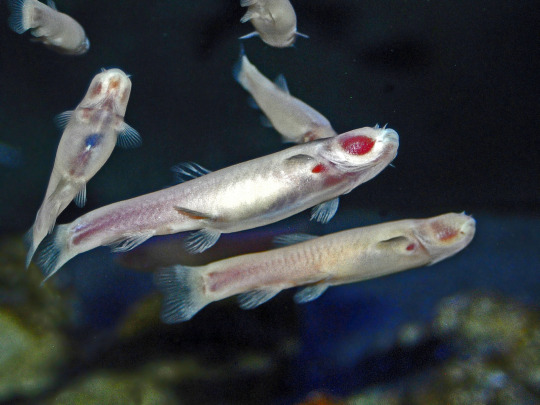
(Image: six Phreatichthys andruzzii. They are long, eyeless, white fish. The blood-filled gills are visible through its translucent skin, seen as a large red patch on the head. End ID)
Before moving on to specific species, it should be noted that cave fish is not a taxonomic category. Cave fish come from many different lines of descent and independently evolved similar adaptations to cave conditions. These similar adaptations are seen in most cave fauna, not just fish, and are collectively called troglomorphism. There are about 300 species of cavefish known to science.
Ophisternon candidum, or the blind cave eel, lives in north Australian caves that are connected to the ocean. Because these caves intake salt water, the pools and streams within them can become very salty, resulting in the eels developing a tolerance to a high range of salinity. They are rare, having been spotted under 40 times since 1959, and thus little is known of their lifestyle. We do know they burrow into sediment and secrete mucus to keep those burrows stable. Males seem to build burrows to woo females. They have been bred in captivity for use un laboratories. At up to 40 cm long, they are huge for cave fish and used to hold the record for the largest species known until another species was found that's even bigger.
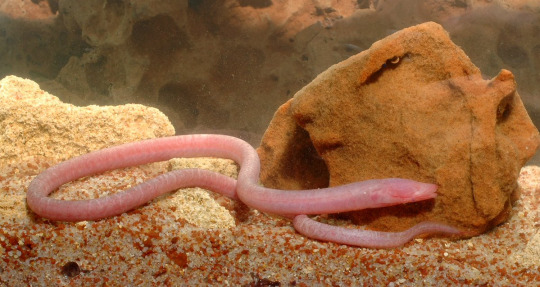
(Image: an eel with translucent, pink skin, no eyes, and ribs visible through the skin. It looks somewhat like an earthworm. End ID)
The actual largest known cave fish is Neolissochilus pnar, which gets up to 40 cm while being more massive than the eel. They are found in a single cave system 100 meters underground in India. The primary food source in the cave appears to be debris from the nearby forest that is washed into the cave during seasonal flooding. The fish may have been known to locals well before it was scientifically described, as there are stories of white cave fish going back over a century in the region.
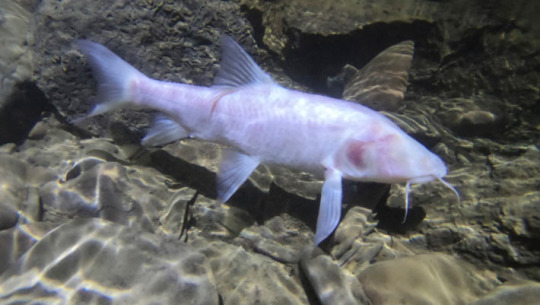
(Image: a small fish with no eyes, white skin, and a long snout with barbels on it)
The Alabama cave fish (Speoplatyrhinus poulsoni) may be the rarest species of freshwater fish in the world. They live exclusively in key cave, Alabama, USA and no more than 10 have ever been seen at a time. The population is estimated to be under 100, below the generally accepted minimum viable population for a species of 200. Fittingly enough, this means a species only found in Alabama may be severely inbred. They are believed to be triggered to mate by seasonal flooding and may be mouth brooders. Climate change-caused changes to flooding and toxins leaking into the groundwater from sewers are currently threatening them with extinction.
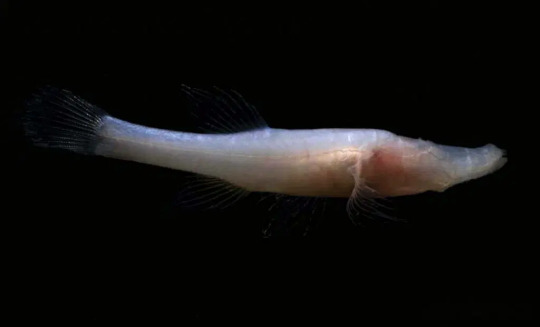
(Image: a long, white, eyeless fish with an elongated snout. Its skeleton is visible through its skin. End ID)
Typhliasina pearsei, the Mexican blind brotula or dama blanca ciega (blind white lady), lives in the cenotes of the Yucatán peninsula. Cenotes are sinkholes filled with groundwater and the ones in the Yucatán are often connected by underground caves, rivers, and aquifers. The fish are apex predators who eat shrimp and mysids and are known to coexist with other cave fish in part of their range. As with other brotulas, they are a rare example of a bony fish that gives live birth. Because of how interconnected and numerous the cenotes are, this species has one of the largest distributions of all cave fish.

(Image: an eyeless white fish with a long tail and elongated rear dorsal and anal fins. It is next to an orange rock. End ID)
Cryptotora thamicola, the cave angel fish or waterfall climbing cave fish, is the adrenaline junkie of the cave fish world. Most cave fish live in slow-moving or still water, but this daredevil lives in rapids. But just living in rapids isn't extreme enough, these guys climb waterfalls. Their large fins with hooked fin rays let them cling onto the rocks while facing into the current. They then allow food to flow right into their mouths. Unlike other walking fish, the waterfall climbers have a well-developed pelvic girdle and walk in a style very similar to tetrapods, with front and back fins alternating strides. This has made them very interesting to evolutionary biologists studying the transition from fish to tetrapods.
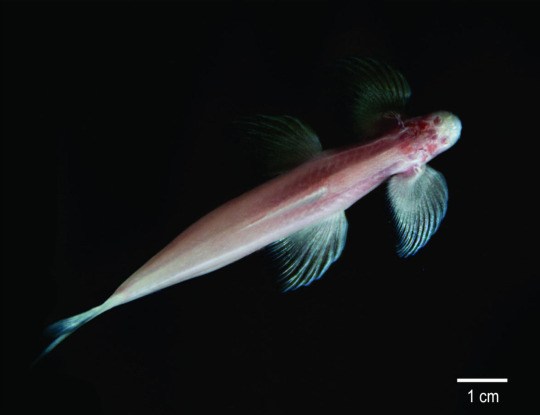
(Image: a typical cave fish with very large pectoral and pelvic fins. End ID)
The Mexican tetra (Astyanax mexicanus) is an example of a handful of fish species that have a cave form and a non-cave form. Most Mexican tetras are perfectly ordinary tetras, but one population has adapted to cave living and has developed trogomorphic traits. The cave from lack pigment, has tastebuds on its head, lacks eyes, and can store more body fat. While you would expect such radical physiological differences to mean the two populations are different species, they aren't. The two populations are fully capable of producing fertile offspring and do so in the wild. If you've ever seen a cave fish in person, there's a good chance it was one of these as the cave form has entered the pet trade and they do very well in captivity, making them the most studied cave fish.
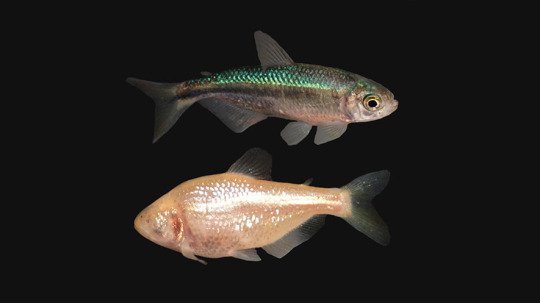
(Image: the non-cave and cave forms of the Mexican tetra seen next to each other for comparison. The non-cave form is a fairly typical silvery-green fish. The cave form is slightly more robust, white, and eyeless. End ID)
Because most cave fish are found only in a singe cave or cave system, they are fully dependent on the health of that cave. Caves tend to be very stable environments, which results in the inhabitants being pretty bad at adapting to change. Changes in water flow, introduction of new species, and pollutants can seriously harm or wipe out whole species. Many species of cave fish are rated as endangered or critically endangered based on their low populations and vulnerability to change.
#wet beast wednesday#I went into this thinking it would be quick and easy to write.#and now it's 6 hours later#cave fish#cave animals#troglofauna#cave#caves#fish#fishblr#fishposting#aquatic life#aquatic biology#biology#zoology#ecology#animal facts#evolution#informative#image described#educational#speleobiology
593 notes
·
View notes
Text
Genome Sequencing Shows Kākāpō Evolved Two Plumage Colors To Evade Predators, study Helmholtz Pioneer Campus, Aotearoa New Zealand Department of Conservation & Māori iwi Ngāi Tahu, pub'd by PLOSBiology
by @GrrlScientist
232 notes
·
View notes
Note
I heard that sharks and rays are super closely related. Are skates an approximate bridging “group” between them? Or are they outside of both groups
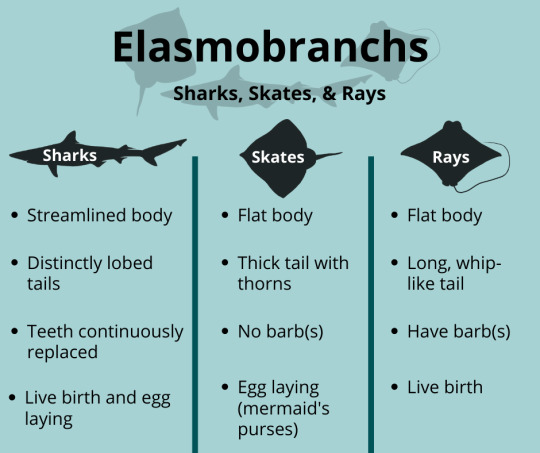
They are all really closely related- there in all the same class known as Chondrichthyes, or cartilaginous fish. Sharks evolved first, approximately 350 million years ago during the Carboniferous period. Skates and ray came around at approximately the same time as each other 150 million years ago during the Jurassic period.
So skates aren't really a "bridging group", they're actually most closely related to rays!
#marine biology#marine ecology#animals#science#biology#animal facts#wildlife#marine life#ocean#fun facts#shark#sharks#rays#sting rays#skates#evolution#zoology#fossils#natural history#jurassic period#carboniferous#sea life#sea creatures#marine animals#fish#chondrichthyes
614 notes
·
View notes
Text
i KNOW this is a bug blog but i wanna talk ab one of my fav guys ever.,.,
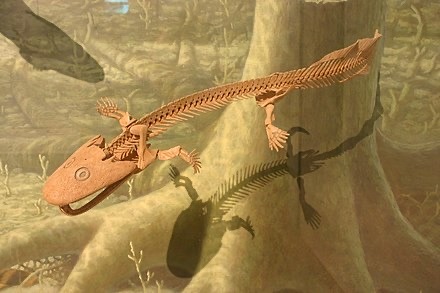

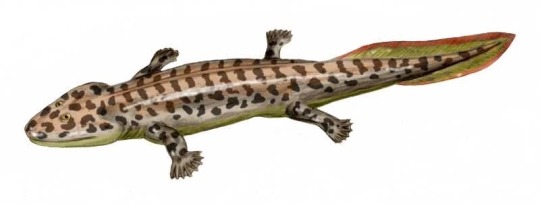
Acanthostega !!!
theyre SO goofy!! appeared in the late devonian, this freaaaky thing has EIGHT DIGITS PER HAND!!! it has limbs but CANNOT bear its own weight, stuck in the waater.
i just love these guys so much <33
#next post WILL be about isopods.#trust!!#ecology#prehistoric#natural history#evolution#paleontology#fossil#acanthostega#devonian#WHY DID I OPEN TUMBLR TO 99+ NOTIFS GANG WHERE DID YOU COME FROM….
736 notes
·
View notes
Text

youtube

youtube
#dungeon meshi#delicious in dungeon#dunmeshi#dungeon meshi posting#video essay#video essays#speculative biology#speculative evolution#speculative zoology#specevo#spec evo#specbio#spec bio#spec zoo#worldbuilding#worldbuilding stuff#speculative ecology#youtube#youtube video#videos#video post#laios touden#laios dungeon meshi#delicious in dungeon laios#marcille donato#marcille dungeon meshi#marcille dunmeshi#delicious in dungeon marcille#falin touden#falin dungeon meshi
123 notes
·
View notes
Text
The Takin is such a whimsical herbivore, like God commissioned Dr. Seuss for this one.




#speculative biology#speculative ecology#speculative evolution#speculative zoology#traditional art#traditional sketch#spectember#paleontology#specposium#fanart#animals#takin#cute animals#paleo meme#paleo#paleoillustration#paleo art#paleontologist#paleoblr#creature#shaggy animal#herbivore#dr. seuss
25K notes
·
View notes
Text
Okay. This is a pretty big deal in the world of mycology. Historically fungi have been divided up into either parasites that siphon resources from plants, mutualists that cooperate with them, or saprotrophs that break down decaying organic matter (plant and otherwise.) The genus in question, Mycena, has traditionally been made of saprotrophic species feeding on decaying wood.
However, what scientists are observing is Mycena fungi displaying primitive mutualistic behaviors, specifically providing living plants with nitrogen and getting carbon in return from a living partner, or getting to chow down on the plant's remains once deceased. This shows a significant level of adaptability that hasn't been observed in fungi beforehand, though given how much we don't know about fungi there's a good possibility this isn't an unprecedented event.
It doesn't surprise me one bit that we're seeing this in Mycena. These fungi are especially opportunistic; in fact, that mushroom growing out of a frog's skin that we saw a while back was also a Mycena species. Perhaps we need to add bonnet mushrooms to raccoons, dandelions, and other hardy generalists as symbols of scrappy survival in spite of environmental pressures.
#Mycena#bonnet mushrooms#mushrooms#mushroom#fungi#fungus#mycelium#mycology#botany#biology#nature#science#scicomm#evolution#environment#ecology#mutualism#mycorrhizal fungi
645 notes
·
View notes
Text
Lacking chlorophyll Dodder (genus Cuscuta) has evolved a parasitic relationship with it’s host plants for water and nutrients. It invades its hosts using specialized structures called haustoria, which penetrate the host plant's vascular system to extract resources - sounds like a 1950s horror thriller. Not welcome on farms as it reduces crop yields.
95 notes
·
View notes
Text
Curiosity is a curious thing. It can be dangerous, as the fabled cat learned too late, but it's also a useful personality trait that can open up invaluable opportunities.
In fact, as a new study illustrates, curiosity seems to be a fundamental force behind biodiversity in the animal kingdom, inspiring individual behaviors that can eventually lead to the evolution of novel species. If not for curiosity, there may never have even been any cats to be killed by it.
The new study focuses not on cats, however, but fish – 57 different species of cichlid fish, specifically, living near the southern shores of Lake Tanganyika in Zambia.
Continue Reading.
187 notes
·
View notes
Text

First named Salii'Qi character :) her name is Sillca and she lives and travels with her rancher girlfriend. Sillca is less hands on and makes and embroiders clothes with hides and fibers found in the desert plants.
Oh, you can also draw her for Artfight if you'd like <3 https://artfight.net/character/3465357.sillca-rasayae
#shes my daughter and i love her so#sillca ra'sayae#salii’qi#saliinthia#alien#spec evo#speculative evolution#speculative ecology#speculative biology#sophont#xenobiology
438 notes
·
View notes